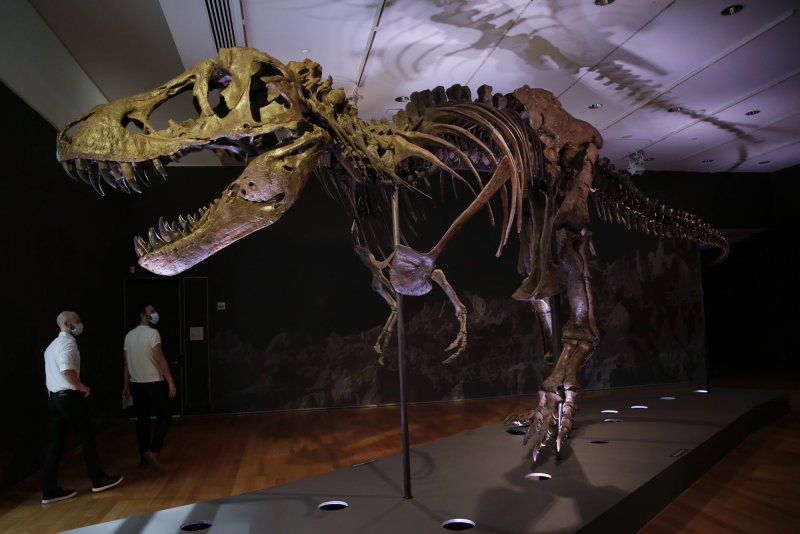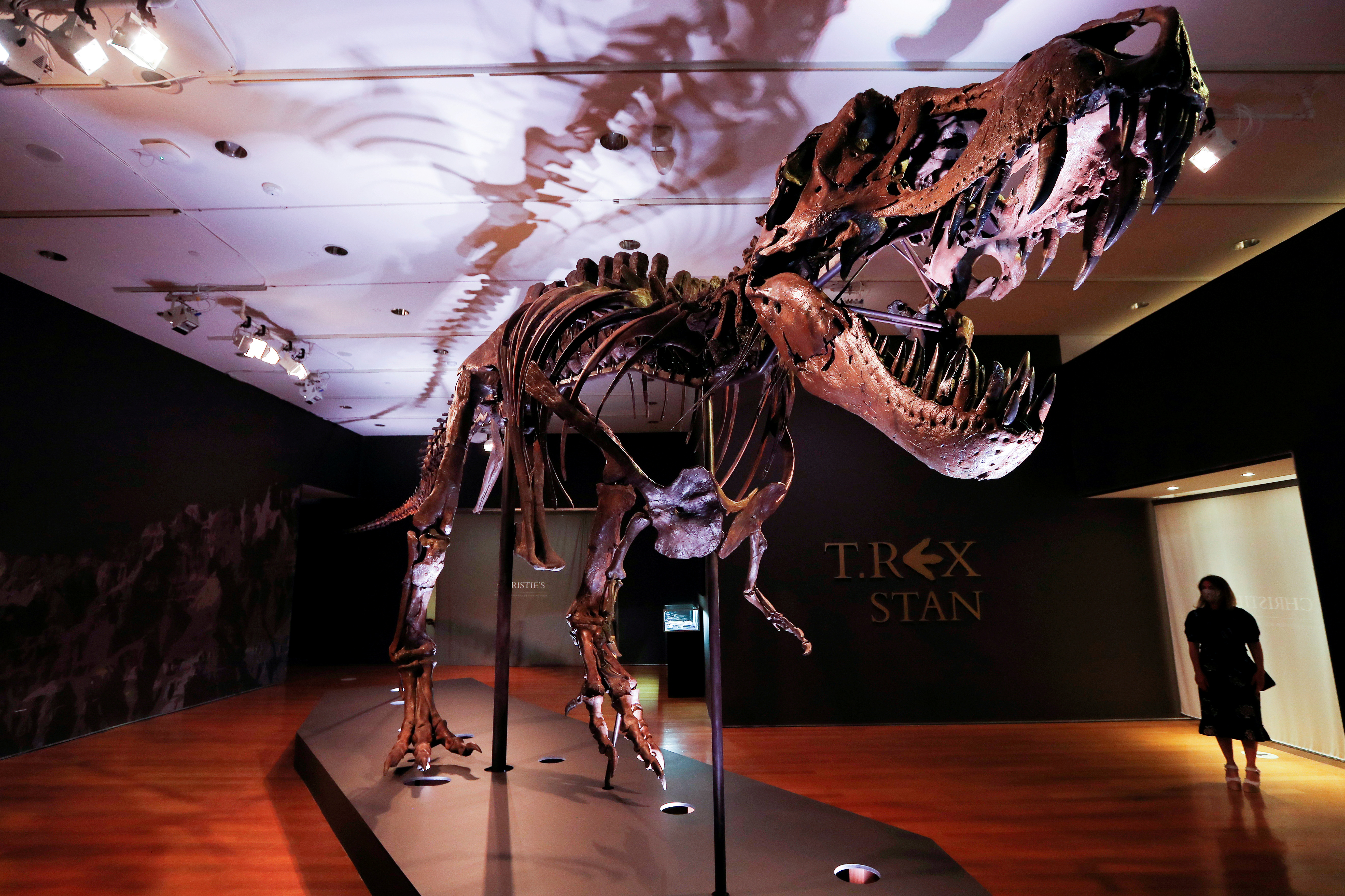Billions of T. rexes walked on North America during the Age of the Dinosaurs

At their peak, North America's Tyrannosaurus rex population numbered 20,000,000 according to a new study. File Photo by John Angelillo/UPI | License Phot
April 15 (UPI) -- Paleontologist Charles Marshall had long wondered how many Tyrannosaurus rex dinosaurs populated the North American continent. A few years ago, finally tired of asking his colleagues for answers, Marshall decided to find out for himself.
With the help of his students, Marshall determined North America's T. rex population peaked at 20,000. That means that over the course of their 2.5 million-year reign atop the Cretaceous food chain, 2.5 billion lived and died on the continent
Marshall and his research partners detailed their novel calculations in a new paper, published Thursday in the journal Science.
"Fossils are rare, but how rare?" Marshall told UPI in an email, speaking to the questions that inspired his investigation. "When I see a T. rex fossil, is it 1 in a million, a billion, a trillion?
RELATED Bite of juvenile T. rex was less ferocious than an adult tyrannosaurus
"And then there is the more general issue of just how much can we know about extinct animals, and how do we go about knowing it," Marshall said. "Finally, why study T. rex in particular? Because it turns out it is one of the best understood dinosaurs!"
Though T. rex is one of the most well understood dinosaur species, the remains of only 100 adults have been discovered, and more than two-thirds of those are represented only by a single bone.
To figure out how many T. rex were living in North America at any given time, Marshall and his research partners couldn't simply make inferences based on the abundance -- or lack -- of T. rex fossils. Instead, the scientists used what they knew about the dinosaur's ecology to establish robust constraints on the variables relevant to the species' abundance.
RELATED Teenage tyrannosaurs, 'megatheropods' limited diversity of smaller dinos
Those variables included: average adult body weight, geographic range, generation time, geological longevity and physiology.
"Most important by far is the relationship among living animus between population density and body mass -- bigger animals are on average rarer," Marshall said. "This relationship is called Damuth's Law, and to apply you also have to know what its trophic level was (carnivore, herbivore) and its physiology, how warm-blooded it is. Without this relationship, the study would have been impossible -- we needed data from the living to make this go."
Body temperature dictates an animal's metabolism, and the higher a species' metabolism, the lower its population density. Lizards, for example, have a slow metabolism, and as a result, their population densities are often 30 to 35 times greater than similarly sized mammals.
RELATED T. rex had big growth spurts, but other theropods matured more steadily
How warm-blooded T. rex was remains a matter of debate, and thus, a significant source of uncertainty in Marshall's calculations.
"The general consensus is that T. rex was warm-blooded, but not as warm-blooded as lions or tigers," Marshall said. "Some have suggested it might be as 'cool' as Komodo dragons (which are hot-blooded compared with regular lizards), but many dinosaur workers disagree, so we split the difference between the average flesh-eating mammals and the Komodo dragon."
The new calculations provide interesting context for the few T. rex fossils that have been recovered from ancient rock deposits. If Marshall's estimates are accurate, that would mean paleontologists have found about 1 in 16,000 of the T. rexes that were perished and buried within Montana's Hell Creek Formation.
Even if Marshall's estimates are a bit off, the calculations offer a roadmap for analyzing the abundance of long-extinct species.
Moving forward, Marshall said he and his research partners plan to repeat their analysis for all of the dinosaur species that were part of the T. rex ecosystem.
"So we can see what that ecosystem looked like, and to begin to see if we can use the preservation rate to estimate how many species of dinosaur the fossil record might have missed."
upi.com/7090669
‘Like Godzilla, but actually real’: study shows T. rex numbered 2.5 billion
Will Dunham
2.5 billion T. rex roamed Earth, study finds
If one Tyrannosaurus rex - the school bus-sized meat-eating dinosaur that stalked the Cretaceous Period landscape - seems impressive, how about 2.5 billion of them?
Researchers on Thursday unveiled the first calculation of the total T. rex population during the estimated 2.4 million years that this fearsome species inhabited western North America during the twilight of the age of dinosaurs.
They considered factors including the size of its geographic range, its body mass, growth pattern, age at sexual maturity, life expectancy, duration of a single generation and the total time that T. rex existed before extinction 66 million years ago. They also heeded a doctrine called Damuth's law linking population to body mass: the bigger the animal, the fewer the individuals.
Their analysis put the total number of T. rex individuals that ever existed at about 2.5 billion, including approximately 20,000 adults alive at any one time.
Fossils of more than 40 T. rex individuals have been found since it was first described in 1905, providing a wealth of information about a beast that thrives in the popular imagination.
"Why iconic?" asked paleontologist Charles Marshall, who led the study published in the journal Science.
"Heck, a hugely massive killer with super-huge teeth, one that you would never dream up on your own if we didn't have the fossil record. So not only super-cool and beyond the imagination, but real. Like Godzilla, but actually real. And I think we like feeling small, and T. rex sure makes us feel small and vulnerable," Marshall said.
It was among the largest carnivorous dinosaurs, possessing a skull about 5 feet (1.5 meters) long, massive and muscular jaws with a bite force capable of crushing bone, a mouthful of banana-sized serrated teeth, a keen sense of smell, strong legs and puny arms with hands boasting just two fingers.


 5
5
An approximately 67 million-year-old Tyrannosaurus rex skeleton, one of the largest, most complete ever discovered and named "STAN" after paleontologist Stan Sacrison who first found it, is seen on display ahead of its public auction at Christie's in New York City, New York, U.S., September 15, 2020. REUTERS/Mike Segar
Perhaps the largest-known T. rex is a specimen named Sue at the Field Museum in Chicago, measuring 40-1/2-foot-long (12.3-meters), weighing an estimated 9 tons and living about 33 years.
The new study put the weight of the average adult T. rex at 5.2 tons, average lifespan at 28 years, generation time at 19 years, total number of generations of the species at about 125,000, and its geographic range at roughly 890,000 square miles (2.3 million square kilometers).
They calculated an average population density of about one T. rex for every roughly 40 square miles (100 square kilometers).
T. rex fossils have been found in Canada's Alberta and Saskatchewan provinces and the U.S. states of Montana, Wyoming, South Dakota, North Dakota, Utah, Colorado, New Mexico and Texas. T. rex apparently met a fiery end when an asteroid slammed into Mexico, exterminating three quarters of Earth's species.
While the uncertainties in the estimates were large and some of the assumptions may be challenged by other paleontologists, the study was a worthwhile effort to expand the understanding of this famous dinosaur, said Marshall, director of the University of California Museum of Paleontology and a University of California, Berkeley professor of integrative biology.
Will Dunham
2.5 billion T. rex roamed Earth, study finds
If one Tyrannosaurus rex - the school bus-sized meat-eating dinosaur that stalked the Cretaceous Period landscape - seems impressive, how about 2.5 billion of them?
Researchers on Thursday unveiled the first calculation of the total T. rex population during the estimated 2.4 million years that this fearsome species inhabited western North America during the twilight of the age of dinosaurs.
They considered factors including the size of its geographic range, its body mass, growth pattern, age at sexual maturity, life expectancy, duration of a single generation and the total time that T. rex existed before extinction 66 million years ago. They also heeded a doctrine called Damuth's law linking population to body mass: the bigger the animal, the fewer the individuals.
Their analysis put the total number of T. rex individuals that ever existed at about 2.5 billion, including approximately 20,000 adults alive at any one time.
Fossils of more than 40 T. rex individuals have been found since it was first described in 1905, providing a wealth of information about a beast that thrives in the popular imagination.
"Why iconic?" asked paleontologist Charles Marshall, who led the study published in the journal Science.
"Heck, a hugely massive killer with super-huge teeth, one that you would never dream up on your own if we didn't have the fossil record. So not only super-cool and beyond the imagination, but real. Like Godzilla, but actually real. And I think we like feeling small, and T. rex sure makes us feel small and vulnerable," Marshall said.
It was among the largest carnivorous dinosaurs, possessing a skull about 5 feet (1.5 meters) long, massive and muscular jaws with a bite force capable of crushing bone, a mouthful of banana-sized serrated teeth, a keen sense of smell, strong legs and puny arms with hands boasting just two fingers.


 5
5An approximately 67 million-year-old Tyrannosaurus rex skeleton, one of the largest, most complete ever discovered and named "STAN" after paleontologist Stan Sacrison who first found it, is seen on display ahead of its public auction at Christie's in New York City, New York, U.S., September 15, 2020. REUTERS/Mike Segar
Perhaps the largest-known T. rex is a specimen named Sue at the Field Museum in Chicago, measuring 40-1/2-foot-long (12.3-meters), weighing an estimated 9 tons and living about 33 years.
The new study put the weight of the average adult T. rex at 5.2 tons, average lifespan at 28 years, generation time at 19 years, total number of generations of the species at about 125,000, and its geographic range at roughly 890,000 square miles (2.3 million square kilometers).
They calculated an average population density of about one T. rex for every roughly 40 square miles (100 square kilometers).
T. rex fossils have been found in Canada's Alberta and Saskatchewan provinces and the U.S. states of Montana, Wyoming, South Dakota, North Dakota, Utah, Colorado, New Mexico and Texas. T. rex apparently met a fiery end when an asteroid slammed into Mexico, exterminating three quarters of Earth's species.
While the uncertainties in the estimates were large and some of the assumptions may be challenged by other paleontologists, the study was a worthwhile effort to expand the understanding of this famous dinosaur, said Marshall, director of the University of California Museum of Paleontology and a University of California, Berkeley professor of integrative biology.
The formula could be applied to other extinct animals, Marshall added.
Paleontologist and study co-author Ashley Poust of the San Diego Natural History Museum said while 2.5 billion is a lot, it represents only about a third of Earth's current human population - and 20,000 is merely the size of a small town.
“They’d have to meet up over possibly long distances to mate, or maybe even care for their young,” Poust said of Tyrannosaurus. “The numbers can seem big and cold, but I guess I see them as a pretty intimate window into their lives.”

No comments:
Post a Comment